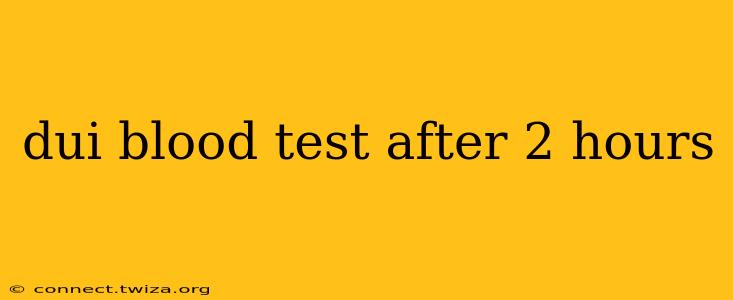A DUI (Driving Under the Influence) arrest often involves blood alcohol content (BAC) testing. Understanding how BAC levels change over time is crucial, especially when considering a blood test taken two hours after driving. This post explores the complexities of BAC testing after a two-hour delay, addressing common questions and misconceptions.
What is a BAC Test and How Does it Work?
A BAC test measures the amount of alcohol in your bloodstream. It's often used to determine impairment levels and prosecute DUI cases. The test can be administered through a breathalyzer (breath test), blood test, or urine test, with blood tests generally considered the most accurate. The results are expressed as a percentage, showing the grams of alcohol per 100 milliliters of blood. For example, a BAC of 0.08% means there are 0.08 grams of alcohol per 100 milliliters of blood. The legal limit for driving varies by state but is commonly 0.08%.
How Does Alcohol Metabolism Affect BAC Levels After 2 Hours?
Alcohol metabolism is the process by which your body breaks down alcohol. This process isn't constant; it varies based on factors such as:
- Body weight: Smaller individuals tend to have higher BAC levels than larger individuals after consuming the same amount of alcohol.
- Gender: Women generally metabolize alcohol slower than men.
- Metabolism rate: Individual metabolic rates differ, influencing how quickly alcohol is processed.
- Food consumption: Eating before or during drinking slows alcohol absorption.
- Type of alcohol: Different alcoholic beverages are absorbed and metabolized at different rates.
Because of these variables, predicting a precise BAC level two hours after drinking is difficult. While some alcohol will be metabolized within that timeframe, a significant amount may still remain in the bloodstream, potentially leading to a BAC above the legal limit.
Can a Blood Test After 2 Hours Still Show Impairment?
Yes, a blood test two hours after driving can still show impairment. Even if your BAC has decreased, it might still be above the legal limit in your state, resulting in a DUI charge. The amount of decrease depends heavily on the factors listed above. A person with a faster metabolism might show a significantly lower BAC after two hours compared to someone with a slower metabolism who consumed a similar amount of alcohol.
What Factors Influence BAC Levels Two Hours Post-Driving?
Several factors influence the BAC reading two hours after driving:
- Initial BAC: The higher your initial BAC, the higher it's likely to be two hours later, even after some metabolism.
- Time since last drink: The closer the last drink was to driving, the higher the BAC is likely to remain.
- Amount of alcohol consumed: The more alcohol consumed, the longer it takes to metabolize.
- Individual differences: Individual variations in metabolism significantly impact the rate of alcohol breakdown.
What Happens if My Blood Test Shows a BAC Above the Legal Limit After 2 Hours?
If your blood test shows a BAC above the legal limit, even two hours after driving, you'll likely face DUI charges. The penalties can range from fines and license suspension to jail time, depending on your state's laws and the specific circumstances of the case. It is crucial to seek legal counsel immediately if you're facing such charges.
How Can I Protect Myself from a DUI?
The best way to avoid a DUI is to avoid driving after drinking alcohol. Designate a driver, use a ride-sharing service, or take a taxi. If you are unsure, err on the side of caution and do not drive.
This information is for educational purposes only and should not be considered legal advice. Consult with a legal professional for guidance on specific DUI cases. The complexities of BAC levels and legal implications necessitate seeking expert advice to navigate potential DUI charges effectively.
